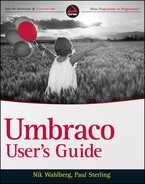12
Working with .NET Controls
- How do you create a macro?
- How do you use macro parameters to pass data?
- How do you create content programmatically?
- What's the best way to interact with unpublished content?
- Why are XSLT extensions so powerful?
- What is the Umbraco event model?
- How do you use LINQ to link to Umbraco?
Because Umbraco is so tightly integrated with standard .NET concepts extending it using .NET user controls, classes, and various configuration methods is easy. This chapter gives you a more detailed look at the power of extending Umbraco using custom .NET code. Plenty of examples should get you started creating custom Web applications in no time.
The assumption in this chapter, as well as the book, is that you have previous experience with and working knowledge of the following concepts:
- Working with Microsoft Visual Studio to create solutions and projects
- Creating and working with user controls (.ascx)
- Extending and working with .NET classes
- .NET events
- Deploying files to a website
 For great examples of how other community developers have extended Umbraco, check out the projects repository at http://our.umbraco.org/projects.
For great examples of how other community developers have extended Umbraco, check out the projects repository at http://our.umbraco.org/projects.
One of the benefits of using .NET to interact with Umbraco content is that it allows you to retrieve content that is not published, as opposed to XSLT, where you only have access to the published content (from cache). The exception to this is using XSLT extensions, which are covered later in this chapter (and which are still powered by .NET code).
